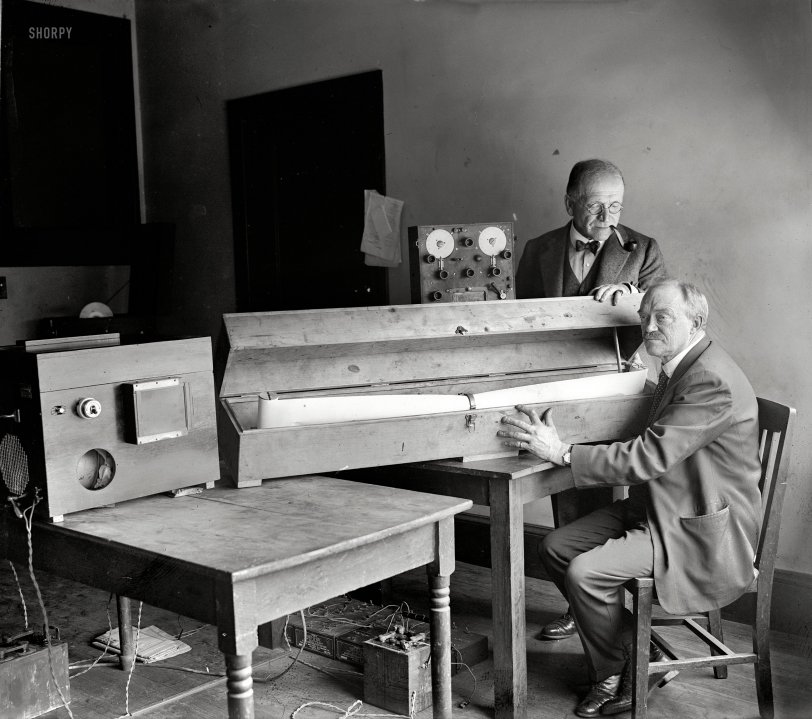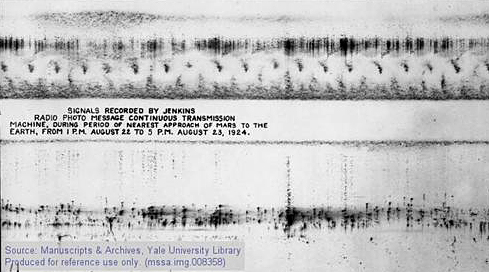


Framed or unframed, desk size to sofa size, printed by us in Arizona and Alabama since 2007. Explore now.
Shorpy is funded by you. Patreon contributors get an ad-free experience.
Learn more.

- Roll your own
- Rugged and real!
- A Charles Purcell - Mama Cass Connection
- Uncle SAAM
- Obfuscation
- One Chocolate Soldier rode away
- Victor Marquis de la Roche
- The Little House Across Way ...
- Vanderbilt Gates
- Vanderbilt Mansion
- You can still see that gate
- Withering heights for me
- So Jim,
- Top Heavy
- Re: Can't Place It.
- Bus ID
- Since you mention it
- The White Pages ?
- Moonlight Tower
- 1907?
- Fire(men) and Water
- Can't Place It
- Can anyone
- Wings
- Where's Claudette and Clark?
- Overbuilt Rolodex
- One song
- Give Me Wings Please!
- PRR
- Pinball Wizards
Printporium
Listening to Mars: 1924

August 21, 1924. Washington, D.C. "Dr. David Todd & C.F. Jenkins." Scroll down to the comments for an explanation of this unusual device. Thanks to Splunge, Stanton Square and others for filling in the blanks. View full size.
Mars, Aliens & the New York Times
This photo is in today's New York Times:
https://www.nytimes.com/2024/08/20/science/mars-aliens-radio-signals.htm...
Near VLF
Their listening frequency of 50 kHz (6000 meters) is almost VLF http://en.wikipedia.org/wiki/Very_low_frequency and an odd choice for trying to monitor any extraterrestrial signals where even the nighttime ionosphere would have likely blocked them from reaching the earth's surface. What they got was most likely, as others have suggested, electrical interference from earth-based sources (natural and manmade).
Not too many years late Karl Jansky with Bell Labs http://en.wikipedia.org/wiki/Karl_Guthe_Jansky did receive extraterrestrial signals at a much higher frequency (20.5 MHz, c. 15 meters).
Curious Picturization
Washington Post, August 27, 1924.Weird “Radio Signal” Film
Deepens Mystery of MarsPictorially Recorded Messages Here Mere Tangles Mass of Dots and Dashes—Growing Wonderment May Bring Tenable Interpretation Theory.
The mystery surrounding strange radio signals heard in various parts of the world in the “nearest-to-earth” visit of Mars on Friday and Saturday was deepened yesterday, when the film in the special machine operated here to record such “signals” was developed photographically.
The result was a curious picturization of radio phenomenon. Thirty feet long and six inches wide, the chemically treated film showed, black on white, everything that was “picked up” out of the air in about 29 hours with a receiving apparatus adjusted to a wave length of 6,000 meters. The “messages” ranged from a fairly regular arrangement of dots and dashes, running the full length of the film down its left side, to pictures weirdly resembling a face, repeated at regular intervals on the right side of the film.
C. Francis Jenkins, inventor of the “radio photo message continuous transmission machine” used in the experiment in his laboratory, 1515 Connecticut avenue northwest, doubted that the recorded radio sounds had anything to do with Mars. He declared, however, that it was the most curious phenomenon ever photographed by his apparatus.
Mr. Jenkins was reluctant at first to have part of the film reproduced, fearing that it might be regarded by the public as a hoax. He was prevailed upon, however, because of the widespread interest in the experiment, to permit its reproduction. He wished it understood that it was a scientific curiosity, and not belief in the existence of intelligent beings on Mars, that caused him to use his machine for this purpose.
“I don't think the results have anything to do with Mars,” Mr. Jenkins said. “Quite likely the sounds recorded are the result of heterodyning, or interference of radio signals. The film shows a repetition, at intervals of about a half hour, of what appears to be a man's face. It's a freak which we can't explain.”
Dr. David Todd, professor emeritus of astronomy at Amherst college, who enlisted Mr. Jenkins' cooperation in the widespread “listening-in on Mars” plan which he organized, was equally at a loss to account for the freak results. He regarded the film seriously, however.
“We now have a permanent record which can be studied, and who knows, until we have studied it, just what these signals may have been? But the important thing is to have a record.”
“Three years ago Marconi was reported as saying he had heard signals from Mars. A few days ago he was quoted as saying he was too busy to listen to possible messages from Mars and that it was a ridiculous idea to do so. He changed his mind, and no one knows what he heard the first time. With our photograph, however, it is not a question of what one man heard. It is a permanent record, which all can study.”
Dr. Todd said he turned over about 12 feet of the developed film to William F. Friedman, chief of the code section in the office of the chief signal officer of the Army. Friedman, the astronomer said, will try to decipher the strange signals.
Another strip of the film will be submitted today by Mr. Jenkins to Dr. J.H. Dellinger, chief of the radio division of the bureau of standards. The inventor hopes the bureau's experts may be able to determine the cause of the curious record. He had expected no more than a blank on the film, and said he is certain the record could not be caused by a defect in operation of his apparatus. The film was the same kind used on other occasions, he asserted.
“As the film unwinds,” he explained, “an instrument passes over it from left to right 50 times every inch. An incoming sound causes a light to be flashed on the film, and this produces a black line.”
Discussing the striking resemblance of some of the “faces” on the film to artists' and writers' conceptions of the theoretical Martians, as shown in novels and pictures, Dr. Todd said:
“The Jenkins machine is perhaps the hypothetical Martians' best chance of making themselves known to earth. If they have, as well they may, a machine that now is transmitting earthward their 'close-up' of faces, scenes, buildings, landscapes and what not, their sunlight values having been converted into electric values before projection earthward, all these would surely register on the weirdly unique little mechanism. ”
Repetitive noise
I noticed there is repetition of about 20 times in the top strip, and the duration of 20 hours was utilized. I would think they are recording radio noise found at frequencies of their local environment and burning it to paper on the traveling paper strip. "Solar wind?" not likely. More probable local static noise on the radio band. Perhaps the repetition was a Washington DC trolley that drove by on the hour. Anything that made sparks.
David Todd, Vital Engineer
As an astronomer, poor David Peck Todd had almost nothing but bad luck. He realized too late that he might have discovered the moons of Mars if an adjusting screw on his telescope hadn't blocked his view, and every one of the solar eclipses he voyaged to observe wound up being obscured by clouds. He's probably all but forgotten to science, but in literary history he lives on in a small, sad, secure footnote. His wife, Mabel Loomis Todd, became the mistress of Emily Dickinson's brother and then the first editor of Dickinson's poetry.
So here's a last view of David, from Polly Longsworth's biography Austin and Mabel: The Amherst Affair and Love Letters of Austin Dickinson and Mabel Loomis Todd.
"During his late fifties David's behavior grew increasingly erratic, which led in 1917 to his being eased off the Amherst faculty into early retirement. . . . David was institutionalized in 1922, and spent his last seventeen years in a series of hospitals and nursing homes. The endless schemes and designs that always preoccupied him culminated during those final years in a great plan he called 'Vital Engineering,' a program for eternal life."
Direct from Mars
Fascinating!
Here's what they recorded - direct from Mars.

How do we get--
a patent on a roll of paper in a long wooden box? next, what will we call it?
Three-Handled-Moss-Covered
... whatchamacallit.
Not sure what it is, But I'm certain we can't live without it. It appears to be battery-powered, though, which lends to its great portability!
Radiotelescope
Here's what they were doing. Radio-telescoping the face on Mars?
Message from Mars?
A caption on a different image of these two gentlemen (with a third individual) can be found in the Corbis collection with the following caption: "C.F. Jenkins, Wm. F. Friedman, army code expert, and Prof. David Todd, trying to decipher a weird mass of dots and dashes and the film used in a special machine to receive any messages from the planet Mars." The Yale Archives, David Peck Todd Papers, contains an image of the actual printout, captioned: "Mars signals - 1924; Photos of radio signals, 22 August 1924."
C.F. Jenkins (Charles Francis) was a pioneer in early television. Only a few years after this photograph was taken, he opened the first television broadcasting station in the United States.
The "listening experiment"
Dr. David Todd was professor emeritus of astronomy at Amherst College. The device in question was a Jenkins Radio Camera. The experiment was to listen for signals from Mars, which was then passing closer to Earth than it would for another 76 years. The rest of the story can be found here (search the page for "Marconi-Todd" if you want to skip the background material).
What is in the box?
My guess is that the small square box is a camera. What is in the long box baffles me. Film? My first thought was calculator but the small box looks more like a camera to me.
























On Shorpy:
Today’s Top 5